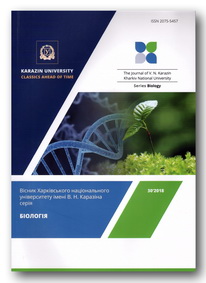Further evidence for redox activation of the plasmid – dirhenium(III) complexes interactions
Abstract
The DNA-interactions in vitro are still necessary investigations for determination of the possible anticancer properties of the compounds, candidates for application in cancer therapy. The aim of the present work was to realize if the interaction of cis-dicarboxylates of dirhenium(III), with pivalato- (I), isobutirato- (II) and adamanthyl- (III) ligands cleaves the plasmid in the same manner and what is the influence of the ligands on this process. For experiments we used the prokaryotic plasmid which is good model to analyze DNA-cleaving ability of different substances that exists in supercoiled conformation and turns to nicked and linear forms. It was shown that gradual conversion of the supercoiled Form I to a mixture of supercoiled (Form I) and nicked (Form II) DNA takes place and increasing amounts of Form II are produced with higher concentrations of I–III under increasing of concentration that showed the DNA-cleaving abilities of all investigated dirhenium complexes. This process was taking place with different intensity in the range I ˃ II ˃ III, that demonstrates the influence of the organic radical on the cleaving activity of the dirhenium(III) complexes. Under hydrogen peroxide conditions, I and II showed close results, demonstrating more intensive process of cleaving, including formation of the linear plasmid (Form III) under higher concentration, witnessing about redox-activation of the DNA-cleaving reaction. Cleaving activity of III was approximately the same in all experiments, that was demonstrated only by decreasing of the supercoiled form I and increasing of the nicked form II of the plasmid and by absolutely absence of the linear form III of the plasmid. The electrophoresis mobility shift assays showed that rhenium cluster compounds have nuclease activity and confirmed that natural DNA may be their target in the living cells. The conclusion was made that the mechanism of DNA-cleavage reaction of the dirhenium(III) complexes is multiple in which the electron donating (withdrawing) effects of the ligands and catalytic activity of the metal core should be taken in consideration.
Downloads
References
Aykin-Burns N., Ahmad I.M., Zhu Y. et al. (2009). Increased levels of superoxide and H2O2 mediate the differential susceptibility of cancer cells versus normal cells to glucose deprivation. Biochem. J., 418, 29−37. https://doi.org/10.1042/BJ20081258
Decker A., Chow M.S., Kemsley J.N. et al. (2006). Direct hydrogen-atom abstraction by activated bleomycin: an experimental and computational study. J. Am. Chem. Soc., 128, 4719–4733. https://doi.org/10.1021/ja057378n
Dunham S.U., Chifotides H.T., Mikulski S. et al. (2005). Covalent binding and interstrand cross-linking of duplex DNA by dirhodium(II,II) carboxylate compounds. Biochemistry, 44, 996–1003. https://doi.org/10.1021/bi0486637
Golichenko A.A., Shtemenko A.V. (2006). Cluster rhenium(III) complexes with adamantanecarboxylic acids: synthesis and properties. Rus. J. of Coord. Chem., 32, 242–249. https://doi.org/10.1134/S1070328406040038
Golichenko A.A., Shtemenko A.V. (2015). Crystal structure of di-μ-isobutyrato-κ4O:O′-bis[cis-dichlorido(dimethysulfoxide-κS)rhenium(III). Acta Cryst. Section E: Cryst. Com., E71, 1219–1221. https://doi.org/10.1107/S2056989015017429
Ismail M.B., Booysen I.N., Akerman M.P. (2019). DNA interaction studies of rhenium compounds with Schiff base chelates encompassing biologically relevant moieties. Nucleosides, Nucleotides and Nucleic Acids, 38(12), 950–971. https://doi.org/10.1080/15257770.2019.1639058
Kadoya Y., Fukui K., Hata M. et al. (2019). Oxidative DNA cleavage, formation of µ-1,1-hydrperoxo species and cytotoxicity of dicopper(II) complex supported by a p-cresol-derived amide-tether ligand. Inorganic Chemistry, 58(21), 14294–14298. https://doi.org/10.1021/acs.inorgchem.9b02093
Keck M.V., Lippard S.J. (1992). Unwinding of supercoiled DNA by platinum ethidium and related complexes. J. Am. Chem. Soc., 114, 3386–3390. https://doi.org/10.1021/ja00035a033
Kettenmann S.D., Louka F.R., Marine E. et al. (2018). Efficient artificial nucleases for mediating DNA cleavage based on tuning the steric effect in the pyridyl derivatives of tripod tetraamine-cobalt(ii) complexes. Eur. J. Inorg. Chem., 2018, 2322–2338. https://doi.org/10.1002/ejic.201800276
Leus I.V., Shamelashvili K.L., Skorik O.D. et al. (2012). Antioxidant and antitumor activity of dirhenium dicarboxylates in animals with Guerin carcinoma. Ukr. Biokhim. Zh., 84(3), 87–96. (In Ukrainian)
Mitra K., Kim W., Daniels J.S., Gates K.S. (1997). Oxidative DNA cleavage by the antitumor antibiotic leinamycin and simple 1,2-dithiolan-3-one 1-oxides: evidence for thiol-dependent conversion of molecular oxygen to DNA-cleaving oxygen radicals mediated by polysulfides. J. Am. Chem. Soc., 119, 11691–11692. https://doi.org/10.1021/ja971359z
Nogueira V., Hay N. (2013). Molecular pathways: reactive oxygen species homeostasis in cancer cells and implications for cancer therapy. Clin. Cancer Res., 19, 4309−4314. https://doi.org/10.1158/1078-0432.CCR-12-1424
Paramonova K., Golichenko A., Babiy S. et al. (2016). The interaction of DNA with cluster rhenium compounds of different structural types. World of Med. and Biol., 56(2), 140–144.
Polokhina K., Golichenko A., Babiy S. et al. (2016). Investigation of the interaction of cluster compounds of rhenium with biological active ligands with supercoiled DNA by electronic spectroscopy. Visnyk of Lviv University, Biol. series, 72, 15–24.
Sears R.B., Joyce L.E., Ojami M. et al. (2013). Photoinduced ligand exchange and DNA binding of cis-[Ru(phpy)(phen)(CH3CN)2]+ with long wavelength visible light. J. Inorg. Biochem., 121, 77–87. https://doi.org/10.1016/j.jinorgbio.2012.12.003
Shamelashvili K.L., Shtemenko N.I., Leus І.V. et al. (2016). Changes in oxidative stress intensity in blood of tumor-bearing rats following different modes of administration of rhenium-platinum system. Ukr. Biochem. Journal, 88(4), 29–39. https://doi.org/10.15407/ubj88.04.029
Shtemenko N.I., Chifotides H.T., Domasevitch K.V. et al. (2013). Synthesis, X-ray structure, interactions with DNA, remarkable in vivo tumor growth suppression and nephroprotective activity of cis-tetrachloro-dipivalato dirhenium(III). J. of Inorg. Biochem., 129, 127–134. https://doi.org/10.1016/j.jinorgbio.2013.09.001
Vilfan I.D., Conwell C.C., Sarkar T., Hud N.V. (2006). Time study of DNA condensate morphology: implications regarding the nucleation, growth, and equilibrium populations of toroids and rods. Biochemistry, 45, 8174–8183. https://doi.org/10.1021/bi060396c
Wang W., Lee Y.A., Kim G. et al. (2015). Oxidative DNA cleavage by Cu(II) complexes: effect of periphery substituent groups. J. Inorg. Biochem., 153, 143–149. https://doi.org/10.1016/j.jinorgbio.2015.07.015
Zhou D., Shao L., Spitz D.R. (2014). Reactive oxygen species in normal and tumor stem cells. Adv. Cancer Res., 122, 1–67. https://doi.org/10.1016/B978-0-12-420117-0.00001-3
Authors retain copyright of their work and grant the journal the right of its first publication under the terms of the Creative Commons Attribution License 4.0 International (CC BY 4.0), that allows others to share the work with an acknowledgement of the work's authorship.




